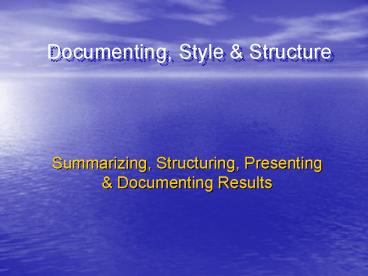Summarizing, Structuring, Presenting - PowerPoint PPT Presentation
1 / 15
Title:
Summarizing, Structuring, Presenting
Description:
plan what you're going to do before. starting & working on ... the essay stronger and sounder. Citing Sources. It's never been more important for you to get in ... – PowerPoint PPT presentation
Number of Views:49
Avg rating:3.0/5.0
Title: Summarizing, Structuring, Presenting
1
Summarizing, Structuring, Presenting
Documenting Results
Documenting, Style Structure
2
First Things First
- Think about the assignment (again), plan what
youre going to do before starting working on
your paper - For a research paper, the following steps are
important - Outline
- First Draft
- Rewrite
- Final Version
3
Summarizing Research
- What does each source tell you?
- What is the perspective of the source?
- Is this an overview of the injury?
- A traditional therapy?
- A nontraditional therapy?
- Is it written by a therapist? a physician? an
athletic trainer? - Does that matter?
4
Evaluate the Resources
- Look at the textbooks and journal articles using
appropriate criteria - Who is the publisher? Who is the author? Who is
the audience? - Is it peer reviewed? Editorially reviewed? Not
reviewed? - Is it understandable? Is it original research? A
review of previous research? An informative
piece based on experience? - Use all the criteria presented previously to
ensure appropriate resources are used
5
Structuring the Paper
- Look at the directions for the paper
- Be sure each criteria is satisfied
- Begin looking at the resources youre going to
use to respond to each part of the assignment - Gather more resources as needed
6
Information Literacy Definition
- Within the context of lifelong learning and
the broad information continuum which ranges
from data to knowledge to wisdom, information
literacy competency focuses on five broad
abilities - to recognize the need for information
- to know how to access information
- to understand how to evaluate information
- to know how to synthesize information
- to be able to communicate information
7
The Benefits of Citing Sources
- Many students do not realize that whenever
they cite a source, they are strengthening
their writing. Citing a source, whether
paraphrased or quoted, reveals that they have
performed research well and synthesized the
findings into their own argument. Using sources
shows that a student is engaged in "the great
conversation," the world of ideas, and that
the student is aware of other thinkers'
positions on the topic. By quoting (and citing)
writers who support the student's position, the
student gains strength for the position. By
responding reasonably to those who oppose it,
the student shows that there are valid
counter arguments. In a nutshell, citing helps
make the essay stronger and sounder.
8
Citing Sources
- It's never been more important for you to get
in the habit of giving credit to those who
supplied you with valuable ideas, data,
experiments, pictures, photographs, etc. And,
it's never been simpler to cite them
correctly. - More and more databases, such as EBSCO, are
automatically providing citations in the
proper style
9
EBSCO Automatically Provides Style Formatting!
10
What is a DOI (Digital Object Identifier)?
- Reliably identifies digital objects
- Appropriately archives the article
- The publisher uses this number to provide a link
to the digital information - Recognize their growing use in scientific
literature - For more information about DOI, go to
http//www.doi.org.
11
Locating the DOI
- For instance, in the Internet editions of the
American Chemical Society journals - DOI appears at the top of the HTML version of an
article and at the bottom of the first page in
its PDF version - In the print editions
- DOI appears in the same location as in the PDF
version.
12
Cite Your Sources Properly
- Let the reader know whose thoughts are being
used to make the point and provide the
appropriate documentation - Avoid plagiarism
- Do not copy someone elses work. Its fraud!
- No person shall submit as his own to an
instructor any work which contains ideas or
materials taken from another without full
acknowledgment of the author the source.
McKendree Colleges Academic Integrity Policy
13
Strategies of Awareness Ethical and
Legal Issues
- Recognize the larger issues regarding information
literacy. Ethical considerations do not
vanish once you are finished with school.
They deal with how you are perceived and
judged in the real world at home, at work
and professionally. After all, stealing is
illegal, immoral unethical. Just ask an
Enron manager. - The information literate student understands the
economic, legal, and social issues
surrounding the use of information and
accesses and uses information ethically and
legally. - Understanding the legal and ethical issues
surrounding information is much more than
plagiarism, the students "hot topic." Other
significant aspects include the freedom of
speech, privacy, intellectual property, fair use
more.
14
A Wide Variety of Styles
- Additional Formatting Assistance
- How Do I..?
- McKendree College Writing Center's Resources
- OWL's Using APA Style
- Documenting Online Resources
- Electronic Media and URLs
- General Forms for Electronic References
- Reference Examples for Electronic Source
Materials - Citations in Text of Electronic Material
15
Need Help?
Visit the Writing Resource Center
Clark 201, 537-6858, writingcenter_at_mckendree
.edu
The Writing Resource Center helps writers help
themselves. They will not just proofread a
paper. Their job is, instead, to help students
become better writers. They offer help with the
following Developing invention
techniques Creating a good thesis Improving
organizational skills Improving audience
awareness Improving unity and
coherence Improving proofreading
skills Improving grammar skills Developing
sentence clarity Developing methods of
revision Improving research and documentation
skills































